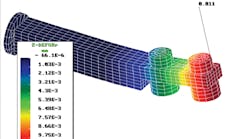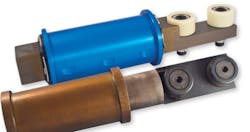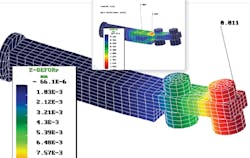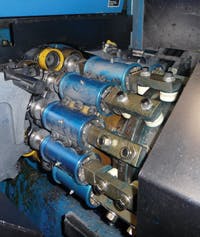Can-making equipment is nothing if not specialized. Yet the subsystems found on these machines offer a number of design lessons that can be applied more broadly by any engineer working to improve the performance and reliability of high-speed equipment.
Consider, for example, the cam-driven ram actuators found on a can line’s necking stations. Mounted on a rotating turret and moving at up to 250 strokes/min, these rams push the round can shell onto a series of shaping dies that gradually reduce the diameter of the can to form its neck.
Traditionally, these rams consisted of a round pin that moved axially within a barrel-like steel housing, with a machined keyway to keep the pin from rotating. A pair of metal cam followers on the rear of the pin directly drive the ram.
Unfortunately, the traditional ram design suffers from three problems. For one, it requires aggressive lubrication to function properly and prevent ram and cam wear. Second, it lets the pin lift and twist in the barrel, causing premature wear. And finally, the traditional design limits the operating speed of the necker.
By eliminating the need for lubrication, we addressed all three problems with a new ram design that serves as a drop-in replacement for traditional units. Here’s how.
Excess wear
Can-making machines run around the clock and typically produce between 2,000 and 3,000 cans/min. One of the chief problems with the traditional design was its propensity to wear out prematurely, despite lubrication.
We analyzed the wear patterns and found that much of it came from an obvious source — metal-on-metal contact between the pin and barrel, and between the cam followers and drive cams. Without lubrication, the ram would quickly fail.
A less-obvious source of wear emerged from a finite-element analysis of the ram. We simulated not only the forces needed to extrude the can neck but also the related centrifugal and acceleration forces. What we found was that the ram deflected upwards and twisted. This deflection significantly increased the effects of metal-on-metal wear throughout the ram assembly. In particular, centrifugal and acceleration forces contributed to wear on the leading edge of the ram body and its keyway, resulting in a telltale “pleating defect” on the can neck.
With all the metal-on-metal contact, ongoing lubrication of the ram and cam followers was essential. That’s why these machines typically have costly automated lubrication systems.
Better materials, less weight
Solving the wear problem involved a change in the ram’s materials and pin geometry. By moving to an aluminum ram and square pin, we cut ram weight by 60% for an equal reduction in centrifugal and pin-acceleration forces. The square shape also better guides the pin during extrusion cycles and distributes forces evenly over a larger area, further diminishing the potential for wear.
Polymers eliminate cam wearSquare rams could not do their job without a cam to propel them. And, in fact, the biggest value of the square ram design is that it extends ram life and eliminates cam wear. Some measure of protection comes from the fact that the lightweight square ram operates at lower forces than traditional round rams. However, clever use of materials plays an even-more important role. The ram redesign replaced metal cam followers with ones made from a self-lubricating polymer. Because the polymer cam followers will not generate wear on the much-harder cam surfaces, this completely eliminates the primary mechanism behind cam failure. While the cost of replacing a ram is not insignificant, it pales in comparison to the cost of replacing the necker cams. The cams themselves are precision ground and expensive. Then there’s the downtime and labor costs to replace the cams. Taken together, these factors mean that in the traditional design, a typical cam change can cost tens of thousands of dollars only to be repeated every few years. |
Even if we did nothing else, the weight reduction would have extended the wear life of the ram, drive cam, and metal cam followers. Yet as long as metal-on-metal contact remained — especially between the cam follower and drive cam — we could not create a lubrication-free system.
Eliminating lubrication altogether meant replacing the original ram’s metal components with self-lubricating polymers. We proposed polymer cam followers and a self-lubricating plastic liner on the ram’s inner surface.
Selecting the right polymers was crucial. However, it’s easier said than done because most such materials are not as strong as metals. And it is important to note that data sheets for self-lubricating polymers do not accurately reflect changes in mechanical properties under operating conditions.
We based material selection on a thorough understanding of the forces involved, which we had from our FEA work. We also performed additional engineering calculations to predict how self-lubricating materials would behave over time under actual operating conditions. Fortunately, we have developed proprietary material models over the years which let us make accurate calculations.
The result of the material and geometry changes has been impressive. Reductions in forces, friction, and wear have at least doubled the life of a typical ram. And the wear-induced pleating defect has dropped from 3% to less than 1% in high-speed lines.
More important, the revamped ram completely eliminated the need to lubricate the ram body and its two cam followers. With a total of 240 rams on a typical 10-stage necker, the redesigned ram gets rid of 720 lubrication points on the machine. It also makes the expensive automatic lubrication system unnecessary.
The payoff
With industrial machines, improvements to a seemingly minor component can often have an outsize payback. The square ram design is a case in point:
- The rams last two to four years longer, reducing the cost and downtime associated with ram replacement.
- They eliminate cam wear and the high cost of replacing worn cams.
- They eliminate the capital expense of an automated lubrication system, and operating costs as high as $6,000/year for one necker.
- They improve yields by reducing the pleating defect.
The redesign also generated some important secondary benefits:
Speed. In can making, line speed equals profit. And the traditional round-ram design imposed a speed limit on necking operations. Made from steel with steel cam followers, these rams typically weighed about 14 lb with a pin that weighed 8 lb. Operating these heavy rams at high speeds triggered high centrifugal forces that accelerated wear. So machine speeds would be dialed down from their design specifications to keep the rams from wearing out prematurely.
To raise the speed limit, we cut ram weight by more than half to 5.2 lb. The moving mass of the pin and cam followers dropped to 3.0 lb. Reducing the weight involved crafting ram components from aircraft aluminum and polymers, rather than steel. Total weight reduction of rotating mass on a 10-stage line is nearly 1 metric ton.
The move to lightweight materials has significantly improved cycle time. Based on the reports from the plants now using the square ram, necker cycle times have dropped on average by 12 to 15% on older machines. On new neckers, the square ram permits operation at or near the design speeds.
Energy savings. By cutting nearly a metric ton of mass that would otherwise have to be accelerated and decelerated, the square ram has lowered necker energy consumption significantly. In some cases, energy costs have dropped by 25%.
Less shock and vibration. Using lightweight materials reduces shock and vibration, which usually represents an important speed constraint in rotating machines. In particular, the polymers used on the ram’s cam followers provide a significant amount of mechanical damping — with the damping properties of the polymers peaking near the operating temperatures of a necker.
The total cost reduction and other benefits associated with square rams has already resulted in their adoption by can-making operations around the globe.
Georg Bartosch, President, Intech Power Corp., Closter, N. J.
Edited by Kenneth J. Korane, [email protected]
Resources: Intech Power Corp., www.intechpower.com



